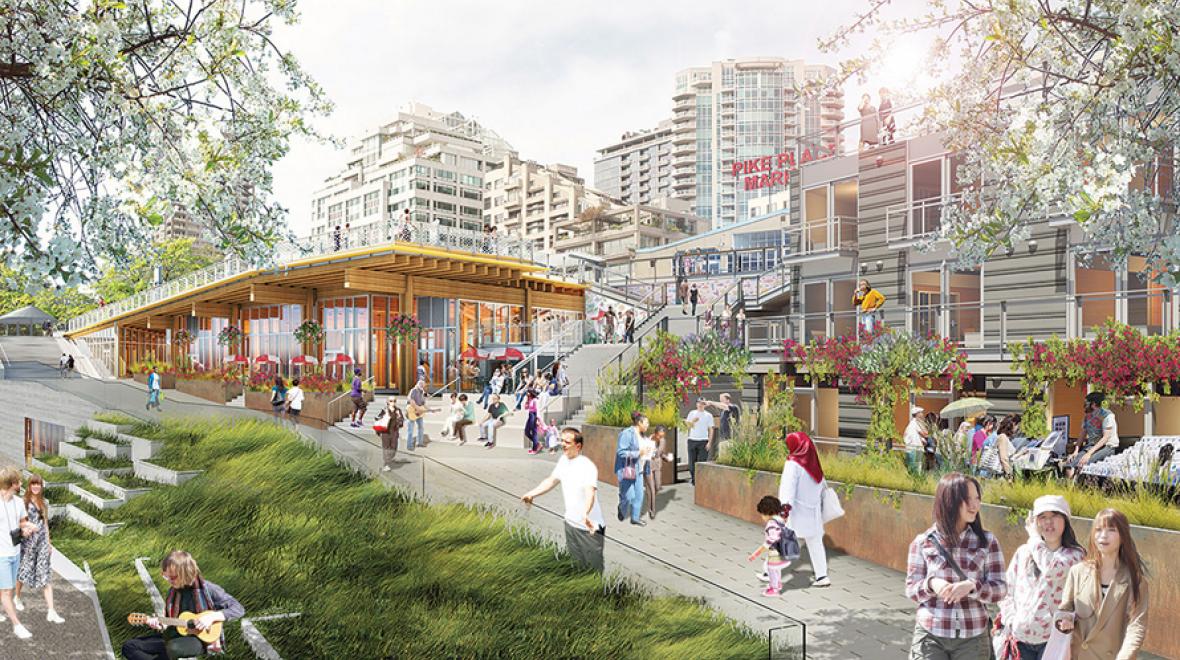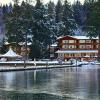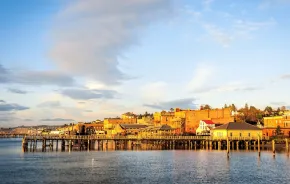
Photo:
Photo credit: Miller Hull
It’s finally (almost) done! On Thursday, June 29, Pike Place Market will officially open the MarketFront, an expansion that fulfills a vision for the Market 40 years in the making. (Psst — The grand opening runs from 2–7 p.m., with an official ceremony at 2 p.m., followed by performances from local musicians.)
Pike Place Market by the numbers
0 tossed fish dropped by the fishmongers at Pike Place Fish Market (self-reported)
1 on-site preschool with 100 kids
2 preserved bats on display in F & J Great Western Trading Co.’s window
5 bookstores
9 acres
23 buildings
70 restaurants
85 farmers licensed to sell at the Market
200-plus treats sold at Sweetie’s Candy in the Down Under
225 craftspeople selling at the Market
500 residents in apartments at the Market
2,350 pounds of chewed gum removed from the Gum Wall in 2015
$10,000 price for Golden Age Collectables’ most expensive comic books (“Batman No. 1” and “Superman No. 1,” both stored off-site)
40,000 tiny doughnuts sold in one day at Daily Dozen Doughnut Company
10,000,000 annual visitors
Built over a parking lot on Western Avenue, the MarketFront will add 30,000 square feet of retail and public open space to the north end of Pike Place Market. The addition takes the form of an airy new retail building with four destination food spots, and a public plaza and canopied vendor area on the building’s rooftop.
Care was taken to maintain and maximize views of the Sound and the Olympics. The project also adds 300 new parking spaces to the Market garage.
Ben Franz-Knight, executive director of Pike Place Market Preservation and Development Authority (PDA), says the MarketFront will offer “a relief valve for the congestion along Pike Place and in the arcades.”
The vendor area will house as many as 47 new day stalls, including spaces for University of Washington business students to test products and for Chief Seattle Club members (homeless and low-income Native Americans) to sell native crafts.
Inside the building, the retail and restaurant tenants will create products on site. Old Stove Brewing Co. will use a Laverne & Shirley–style automatic bottler for its beverages. Indi Chocolates’ candy will dry on a conveyor belt near the shop’s window, while staff at Honest Biscuits will mix and bake as visitors watch. And at Little Fish, the latest venture by Jarr & Co., canning, curing, salting and smoking will be visible from the dining room.
And the best is yet to come: For now, the MarketFront abuts the Viaduct, with a small path leading from the edge of the Market under the Viaduct to the waterfront. But after the Viaduct comes down in 2020, the MarketFront will connect seamlessly to the new waterfront via walkways where pedestrians can enjoy stunning views as they descend.
The expansion is a new peak for the Market, which has had many ups and downs since its opening in 1907. Eight farmers showed up to sell along Pike Place on that first day, and within a week, the Market had 70 vendors.
In the 1930s, the Market featured roughly 600 farmers, many of them Japanese immigrants. The Market lost more than half of its farmers overnight in 1942 with the internment of Japanese Americans — a huge loss that propelled its decline through the ’50s and ’60s. (Look for the artwork above Rachel the Pig honoring the Market’s lost Japanese farmers.)
When the maze of aging buildings was slated for demolition in the ’60s, architect Victor Steinbrueck famously rallied Seattle to “Save the Market.” Voters approved the creation of a historic district in 1971, and in 1973, the City of Seattle established the PDA to manage the Market. Locals and tourists began to return.
You don't know Pike Place
Fix that by reading our age-by-age guide to this historic Seattle destination, and meet the Market's Miss Piggy.
The MarketFront expansion has its roots in another crisis: the 1974 fire that destroyed the Municipal Market Building on Western Avenue. After the fire, the site was used as a parking lot for decades. Eventually, a plan was developed for a new space that everyone could love.
Look for quirky design details at the MarketFront such as visible water pipes and a funky jog in the pathway near the elevator. Three new pieces of public art and a low-rise architectural style complement the rough-hewn aesthetic of the old Market.
But Franz-Knight is most excited about an aspect of the expansion that is largely hidden to visitors: its impact on the Market’s resident community. Opposite the new retail space, for example, 40 new apartments will provide housing for low-income seniors, some of whom were once homeless.
“Nothing could feel better than showing someone who has lived in their car for two years into their new apartment,” he says











